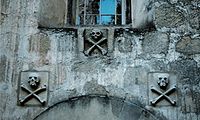
Skull and crossbones (Spanish cemetery)
Encyclopedia


Spain
Spain , officially the Kingdom of Spain languages]] under the European Charter for Regional or Minority Languages. In each of these, Spain's official name is as follows:;;;;;;), is a country and member state of the European Union located in southwestern Europe on the Iberian Peninsula...
cemeteries (campo santo). The practice, dating back many centuries, led to the symbol eventually becoming associated with the concept of death
Death
Death is the permanent termination of the biological functions that sustain a living organism. Phenomena which commonly bring about death include old age, predation, malnutrition, disease, and accidents or trauma resulting in terminal injury....
. Some crucifix
Crucifix
A crucifix is an independent image of Jesus on the cross with a representation of Jesus' body, referred to in English as the corpus , as distinct from a cross with no body....
es feature a skull and crossbones beneath the corpus (the depiction of Jesus'
Jesus
Jesus of Nazareth , commonly referred to as Jesus Christ or simply as Jesus or Christ, is the central figure of Christianity...
body), in reference to a legend that the place of the crucifixion was also the burial place of Adam
Adam and Eve
Adam and Eve were, according to the Genesis creation narratives, the first human couple to inhabit Earth, created by YHWH, the God of the ancient Hebrews...
or, more likely, in reference to the New Testament
New Testament
The New Testament is the second major division of the Christian biblical canon, the first such division being the much longer Old Testament....
statement (King James Version: Matthew 27:33, Mark 15:22, and John 19:17) that the place of his crucifixion was called "Golgotha" (tr. "the Place of a Skull").
Today, an example of a real skull and crossbones may be seen in the 1732 Nuestra Señora del Pilar church overlooking the famous Recoleta Cemetery
La Recoleta Cemetery
La Recoleta Cemetery is a famous cemetery located in the exclusive Recoleta neighbourhood of Buenos Aires, Argentina. It contains the graves of notable people, including Eva Perón, Raúl Alfonsín, and several presidents of Argentina.- History :...
in Buenos Aires
Buenos Aires
Buenos Aires is the capital and largest city of Argentina, and the second-largest metropolitan area in South America, after São Paulo. It is located on the western shore of the estuary of the Río de la Plata, on the southeastern coast of the South American continent...
, Argentina
Argentina
Argentina , officially the Argentine Republic , is the second largest country in South America by land area, after Brazil. It is constituted as a federation of 23 provinces and an autonomous city, Buenos Aires...
. It contains several altars rescued from other early Spanish churches in South America. One of these has twenty rectangular window boxes arrayed behind and above the altar, five wide by four tall. The size of these glass window boxes is such that the femurs of the priests thus interred are a bit too long to lie flat and so must be leaned up in an "X" formation. The other bones fill in the spaces around the femurs with the skull sitting prominently on top of the bone pile centered above the "X".
Other countries
The Jolly RogerJolly Roger
The Jolly Roger is any of various flags flown to identify a ship's crew as pirates. The flag most commonly identified as the Jolly Roger today is the skull and crossbones, a flag consisting of a human skull above two long bones set in an x-mark arrangement on a black field. This design was used by...
, and the similar Totenkopf
Totenkopf
The Totenkopf is the German word for the death's head and an old symbol for death or the dead. It consists usually of the skull and the mandible of the human skeleton...
was a popular symbol of mortality across at this time across Europe and has its origins in the mediaeval Danse Macabre
Danse Macabre
Dance of Death, also variously called Danse Macabre , Danza de la Muerte , Dansa de la Mort , Danza Macabra , Dança da Morte , Totentanz , Dodendans , is an artistic genre of late-medieval allegory on the universality of death: no matter one's...
.
Tombstones from the 18th century in Southern Scotland fairly frequently feature skull and crossbones.
The Church of St Nicholas in Deptford
Deptford
Deptford is a district of south London, England, located on the south bank of the River Thames. It is named after a ford of the River Ravensbourne, and from the mid 16th century to the late 19th was home to Deptford Dockyard, the first of the Royal Navy Dockyards.Deptford and the docks are...
features two Deaths Head
Totenkopf
The Totenkopf is the German word for the death's head and an old symbol for death or the dead. It consists usually of the skull and the mandible of the human skeleton...
s on its gateposts dating to the early 18th century.

